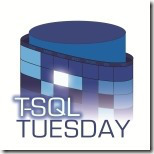
For T-SQL Tuesday #111, Andy Leonard asks “What is your why? Why do you do what you do?”
Like Andy, I didn’t take a straight route into being a DBA. I actually trained as a teacher, and did a variety of temp jobs – largely in call centres – before I got my first “proper” job as a developer.
My first steps into development were when I was a team leader in a call centre. There was a lot of paper shuffling going on. I felt there had to be a better way of doing things, so developed processes using Access and Excel and convinced the Admin team in the benefits of using them.
Not exactly development, more Macros with a bit of VBA, but that got me spotted by another team that were trying to automate reporting in the call centre – again using MS Access. That was where I first encountered relational databases and got deeper into coding. I joined as they were in the process of taking an Excel spreadsheet that processed flat files using macros – taking the whole day/every day to chunder away, replacing it with a coded solution. Finally we had it importing all the call center stats in seconds on a schedule in the early hours.
Nowadays that seems trivial, but back then it felt like a great achievement. It’s still one of my best work memories – when I showed my boss the automated import for the first time.
Moving forward from there and trying to answer Andy’s question, I realised that what started me off is what’s kept moving me forward. That there’s always got to be a better way.
Another of my favourite early developer memories was being asked to look at whether a file import to an application could be sped up as it was taking 10 minutes. The process was to upload a file with corporate credit card statements from a flat file into a SQL database for the application that companies used to manage them. When I opened it up I was quite impressed with the code, it seemed cleverer than anything I could have written – but maybe a bit too clever. I asked myself if there was a better and simpler way of achieving the same thing. There was, and it turned out to be a lot lot quicker.
Making things run faster remained something I loved doing, but it often seemed often that optimisation wasn’t a big focus in application coding – that was more about delivering features. I think that’s part of what led me to specialise in data where performance, particularly at scale, is so key. Looking at SQL code and going – “well, sure it works as it is, but is there not a better way of doing this.”
It strikes me that for a lot of us, this is how we ended up in software, we saw things being done a certain way and saw scope for improvement. Felt that there must be a better way.
And it’s good to remember this isn’t an attitude where we can rest on our laurels. Even when we know what we’re doing, have done something a hundred times before, it’s still good to say “There’s got to be a better way”, and to think about what that might be. Not only does that mean we’re continually improving, but it’s also what keeps working in technology fresh and interesting.


